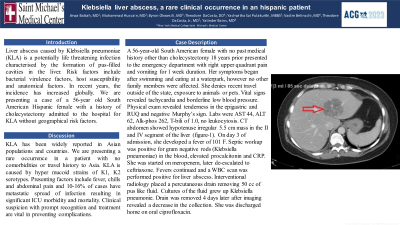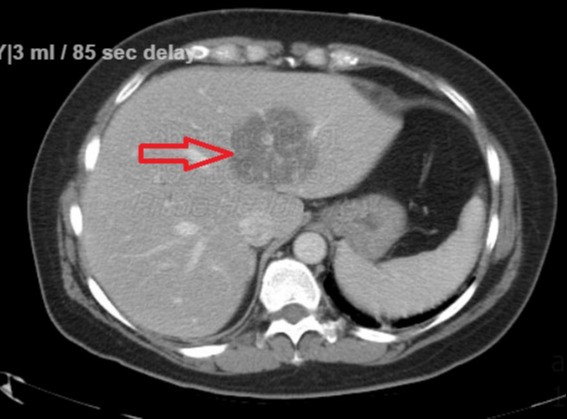Sunday Poster Session
Category: Liver
P1075 - Klebsiella Liver Abscess Is a Serious Infectious Condition Rarely Occurs in Hispanics
Sunday, October 22, 2023
3:30 PM - 7:00 PM PT
Location: Exhibit Hall

Has Audio

Yashwitha Sai Pulakurthi, MBBS
New York Medical College-Saint Michael's Medical Center
Newark, New Jersey
Presenting Author(s)
Arwa Battah, MD1, Muhammad Hussain, MD2, Byron Okwesili, MD2, Theodore DaCosta, DO1, Yashwitha Sai Pulakurthi, MBBS3, Vadim Belinschi, MD4, Rewanth Katamreddy, MD5, Theodore DaCosta, MD1, Yatinder Bains, MD2
1Saint Michael's Medical Center, Newark, NJ; 2Saint Michael's Medical Center, New York Medical College, Newark, NJ; 3New York Medical College-Saint Michael's Medical Center, Newark, NJ; 4Saint Michael's Medical Center, Newark, NJ; 5Saint Michael’s Medical Center, Newark, NJ
Introduction: Liver abscess caused by Klebsiella pneumoniae (KLA) is a potentially life threatening infection characterised by the formation of pus-filled cavities in the liver. Risk factors include bacterial virulence factors, host susceptibility and anatomical factors. In recent years, the incidence has increased globally. We are presenting a case of a 56-year old South American Hispanic female with a history of cholecystectomy admitted to the hospital for KLA without geographical risk factors.
Case Description/Methods: A 56-year-old South American female with no past medical history other than cholecystectomy 18 years prior presented to the emergency department with right upper quadrant pain and vomiting for 1 week duration. Her symptoms began after swimming and eating at a waterpark, however no other family members were affected. She denies recent travel outside of the state, exposure to animals or pets. Vital signs revealed tachycardia and borderline low blood pressure. Physical exam revealed tenderness in the epigastric and RUQ and negative Murphy’s sign. Labs were AST 44, ALT 62, Alk-phos 262, T-bili of 1.0, no leukocytosis. CT abdomen showed hypotenuse irregular 5.5 cm mass in the II and IV segment of the liver (figure-1). On day 3 of admission, she developed a fever of 101 F. Septic workup was positive for gram negative rods (Klebsiella pneumoniae) in the blood, elevated procalcitonin and CRP. She was started on meropenem, later de-escalated to ceftriaxone. Fevers continued and a WBC scan was performed positive for liver abscess. Interventional radiology placed a percutaneous drain removing 50 cc of pus like fluid. Cultures of the fluid grew up Klebsiella pneumonie. Drain was removed 4 days later after imaging revealed a decrease in the collection. She was discharged home on oral ciprofloxacin.
Discussion: KLA has been widely reported in Asian populations and countries. We are presenting a rare occurrence in a patient with no comorbidities or travel history to Asia. KLA is caused by hyper mucoid strains of K1, K2 serotypes. Presenting factors include fever, chills and abdominal pain and 10-16% of cases have metastatic spread of infection resulting in significant ICU morbidity and mortality. Clinical suspicion with prompt recognition and treatment are vital in preventing complications.

Disclosures:
Arwa Battah, MD1, Muhammad Hussain, MD2, Byron Okwesili, MD2, Theodore DaCosta, DO1, Yashwitha Sai Pulakurthi, MBBS3, Vadim Belinschi, MD4, Rewanth Katamreddy, MD5, Theodore DaCosta, MD1, Yatinder Bains, MD2. P1075 - Klebsiella Liver Abscess Is a Serious Infectious Condition Rarely Occurs in Hispanics, ACG 2023 Annual Scientific Meeting Abstracts. Vancouver, BC, Canada: American College of Gastroenterology.
1Saint Michael's Medical Center, Newark, NJ; 2Saint Michael's Medical Center, New York Medical College, Newark, NJ; 3New York Medical College-Saint Michael's Medical Center, Newark, NJ; 4Saint Michael's Medical Center, Newark, NJ; 5Saint Michael’s Medical Center, Newark, NJ
Introduction: Liver abscess caused by Klebsiella pneumoniae (KLA) is a potentially life threatening infection characterised by the formation of pus-filled cavities in the liver. Risk factors include bacterial virulence factors, host susceptibility and anatomical factors. In recent years, the incidence has increased globally. We are presenting a case of a 56-year old South American Hispanic female with a history of cholecystectomy admitted to the hospital for KLA without geographical risk factors.
Case Description/Methods: A 56-year-old South American female with no past medical history other than cholecystectomy 18 years prior presented to the emergency department with right upper quadrant pain and vomiting for 1 week duration. Her symptoms began after swimming and eating at a waterpark, however no other family members were affected. She denies recent travel outside of the state, exposure to animals or pets. Vital signs revealed tachycardia and borderline low blood pressure. Physical exam revealed tenderness in the epigastric and RUQ and negative Murphy’s sign. Labs were AST 44, ALT 62, Alk-phos 262, T-bili of 1.0, no leukocytosis. CT abdomen showed hypotenuse irregular 5.5 cm mass in the II and IV segment of the liver (figure-1). On day 3 of admission, she developed a fever of 101 F. Septic workup was positive for gram negative rods (Klebsiella pneumoniae) in the blood, elevated procalcitonin and CRP. She was started on meropenem, later de-escalated to ceftriaxone. Fevers continued and a WBC scan was performed positive for liver abscess. Interventional radiology placed a percutaneous drain removing 50 cc of pus like fluid. Cultures of the fluid grew up Klebsiella pneumonie. Drain was removed 4 days later after imaging revealed a decrease in the collection. She was discharged home on oral ciprofloxacin.
Discussion: KLA has been widely reported in Asian populations and countries. We are presenting a rare occurrence in a patient with no comorbidities or travel history to Asia. KLA is caused by hyper mucoid strains of K1, K2 serotypes. Presenting factors include fever, chills and abdominal pain and 10-16% of cases have metastatic spread of infection resulting in significant ICU morbidity and mortality. Clinical suspicion with prompt recognition and treatment are vital in preventing complications.

Figure: CT scan of the abdomen with IV contrast reveal a hypodense mass in the live
Disclosures:
Arwa Battah indicated no relevant financial relationships.
Muhammad Hussain indicated no relevant financial relationships.
Byron Okwesili indicated no relevant financial relationships.
Theodore DaCosta indicated no relevant financial relationships.
Yashwitha Sai Pulakurthi indicated no relevant financial relationships.
Vadim Belinschi indicated no relevant financial relationships.
Rewanth Katamreddy indicated no relevant financial relationships.
Theodore DaCosta indicated no relevant financial relationships.
Yatinder Bains indicated no relevant financial relationships.
Arwa Battah, MD1, Muhammad Hussain, MD2, Byron Okwesili, MD2, Theodore DaCosta, DO1, Yashwitha Sai Pulakurthi, MBBS3, Vadim Belinschi, MD4, Rewanth Katamreddy, MD5, Theodore DaCosta, MD1, Yatinder Bains, MD2. P1075 - Klebsiella Liver Abscess Is a Serious Infectious Condition Rarely Occurs in Hispanics, ACG 2023 Annual Scientific Meeting Abstracts. Vancouver, BC, Canada: American College of Gastroenterology.
